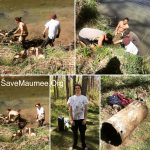Allen County IDEM comment period is now through December 17, 2018 for permitting in the Orthophosphate Pilot Project at the Fort Wayne Water Filtration Plant.
https://www.in.gov/idem/files/notice_20181227_ws_11909.pdf
Save Maumee Member, Daniel Bennett Ph.D. dug into this a bit, and explains,
“I looked for recent orthophosphate references from Fort Wayne Utilities and saw this letter they put out earlier this month and discusses elevated lead results from this Summer.”
https://www.cityoffortwayne.org/images/stories/Utilities/docs/Lead/Lead_results_letter_2018_web.pdf
Fort Wayne employs pH and alkalinity adjustment to control corrosion. Over the years this treatment has proven to be effective. Currently the utility is in process of evaluating addition of orthophosphate to the water to improve corrosion control.
So based on the timing of the permit, Dr. Bennett is assuming that the ”Orthophosphate Pilot Project” is a direct response to these poor lead tests. The purpose of the added orthophosphate then, in this case, is to act as “corrosion inhibitor” in piping systems. The phosphate reacts with metals in the pipe, including lead, to cause them to bind to the chemical in a safe way, rather than becoming loose lead ions that enter the water, and potentially human bodies.
Here’s an FAQ from a water consulting company on using phosphate in water treatment:
http://www.sponwater.com/news.asp?news_id=40
http://www.sponwater.com/news.asp?news_id=41
And here’s a summary from a Winnipeg water company, who presents their seemingly successful orthophosphate treatment program to combat lead contamination:
https://winnipeg.ca/waterandwaste/water/leadOrthophosphate.stm
They do have the statement in there that they add enough phosphate so that “It would take 100 glasses of tap water to get the equivalent dose as in one glass of cola”, which is a good argument that it isn’t a direct danger to humans. However, this statement doesn’t say anything about its environmental effect. In the same argument, what if we replace 1 part in 100 of a freshwater system with Coca-Cola? That feels like it could potentially mess up a river’s biology pretty quickly. Those in charge of Fort Wayne’s own water treatment program should provide evidence that the use of orthophophorus is safe for both those drinking the water and for the nearby natural water systems.
These PowerPoint slides http://www.ohiowea.org/docs/OWEA_Phosphorus_CSM.pdf focus more on the practicalities of measuring phosphate in a water utilities system. More useful probably for a biochemist who knows this stuff. They can’t measure certain types of phosphorus directly in water, so they explain methods of measuring Orthophosphates first, and then measuring all types of Phosphates, and using this ratio to tell how healthy a system measures. This document doesn’t really go into why or how to use these treatments. Although they do mention re-collecting phosphate back out of a system when it’s done its task of removing lead.
Dr Bennett reflects on the research,
If I were to question City Utilities on a program like this, from an environmental standpoint, I would want to know: What is the amount of orthophosphate being used in this treatment process, and is there any method to extract the chemical back out after it’s reacted with lead (and other metals)?
How does this added amount of phosphorus, or the amount expected to reach natural water system, compare to something like the average phosphorus pollution produced by a farming operation’s runoff into a river?
If the amount of phosphorus is anywhere near the same significance as contribution from farm runoff, is there any type of tests or monitoring plan to ensure there’s no additional phosphate pollution that reaches freshwater systems?
Is this pilot program expecting 100% effective results in capturing the chemical reaction process of lead? 
